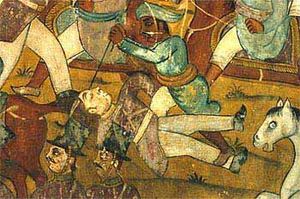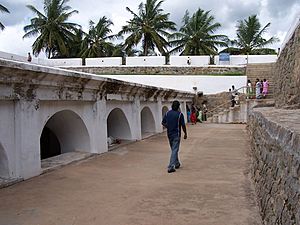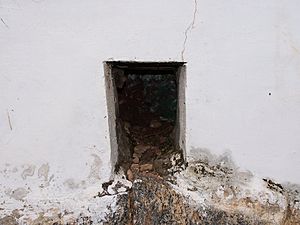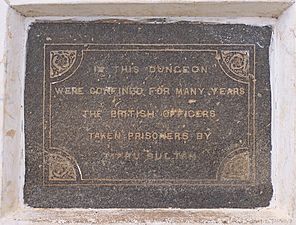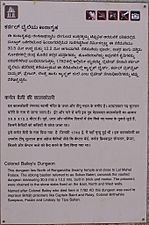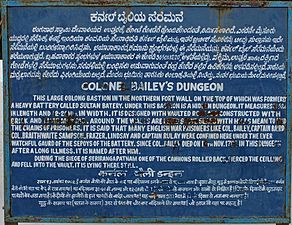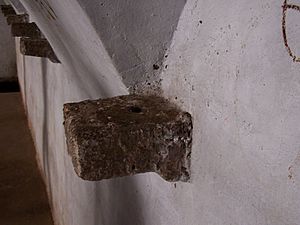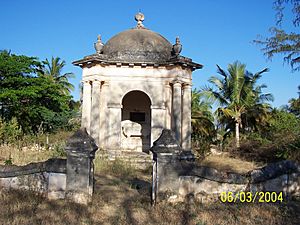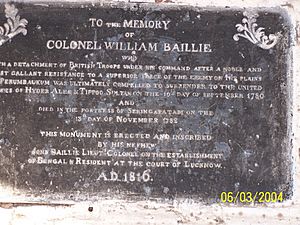Battle of Pollilur (1780) facts for kids
Quick facts for kids Battle of Pollilur |
|||||||
|---|---|---|---|---|---|---|---|
| Part of the Second Anglo-Mysore War | |||||||
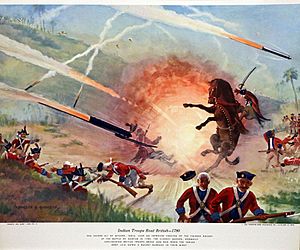 Illustration of the battle |
|||||||
|
|||||||
| Belligerents | |||||||
| Commanders and leaders | |||||||
| Strength | |||||||
| 11,000 | 3,853 | ||||||
| Casualties and losses | |||||||
| Unknown | 2,016 killed 1,000 captured |
||||||
The Battle of Pollilur was a major fight that happened on September 10, 1780. It took place near a city called Kanchipuram in what is now Tamil Nadu, India. This battle was part of the Second Anglo-Mysore War.
The battle was fought between the army of the Kingdom of Mysore, led by Tipu Sultan, and a force from the British East India Company. The British force was commanded by William Baillie. The East India Company suffered a huge defeat. Many of their soldiers were killed or captured. It was one of the worst losses the British East India Company had ever faced in India.
Contents
What Led to the Battle?
Tipu Sultan wanted to stop the British forces from joining up. William Baillie's group was trying to meet another British force. This other group was led by Hector Munro. They were supposed to meet at Conjeevaram.
At the same time, Tipu's father, Hyder Ali, was busy attacking a place called Arcot. Tipu's plan was to keep Baillie's soldiers separate. This would make them easier to defeat.
How the Battle Unfolded
Baillie's soldiers were having a tough time. Some of their men had left, and their leaders were not working well together. They formed a defensive square on a small hill. William Baillie led his men in a final stand.
However, they were completely surrounded by Tipu's army. They were cut off from both Conjeevaram and a strong British fort in Madras. Tipu's forces used a clever tactic called a "double envelopment movement." This means they attacked from both sides, trapping Baillie's men.
Most of Baillie's soldiers were either killed or captured. Only about 50 European officers and 150 men were taken prisoner. Baillie himself was captured and taken to Seringapatam, which is now called Srirangapatnam.
What Happened After?
After the battle, Baillie and many of his officers became prisoners. They were held in the Mysore capital at Seringapatam.
Later, more British soldiers arrived from Calcutta. A new commander named Eyre Coote took charge. He was able to make the situation better for the British. He even launched a counter-attack.
A second battle happened in the same area about a year later.
Amazing Rockets
The Mysore rockets used in this battle were very special. They were much more advanced than anything the British East India Company had seen before. These rockets used iron tubes to hold the fuel. This made them more powerful and able to fly much farther, up to 2 kilometers!
During the Battle of Pollilur, these rockets caused a lot of trouble for the British. They flew low to the ground, hurting many soldiers. One rocket even shattered a British officer's leg.
After Tipu Sultan was finally defeated in the Fourth Anglo-Mysore War, the British captured these Mysore iron rockets. They were so impressed that these rockets helped them develop their own new rockets. These new British rockets, called the Congreve rocket, were later used in the Napoleonic Wars.
Gallery
-
Tipu Sultan had this huge painting, The Battle of Pollilur, made for the Daria Daulat Bagh. It shows his great victory in the battle.
See also
- Tipu Sultan
- Hyder Ali
- Mughal weapons


